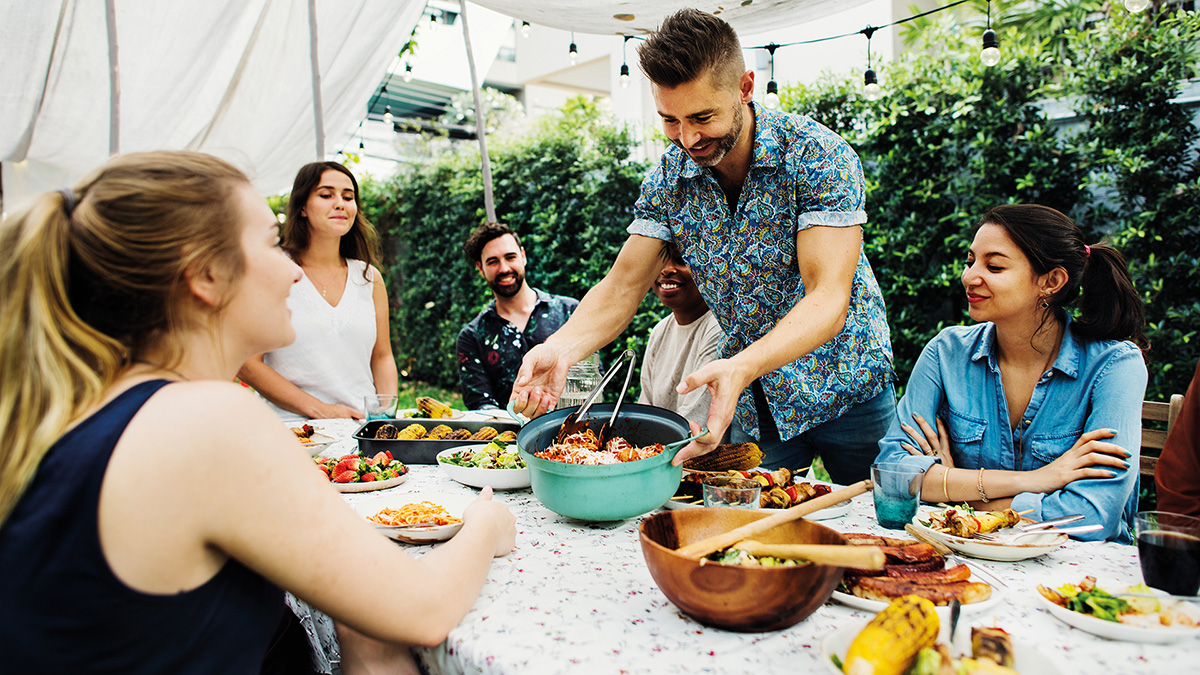
Growing up I loved to read about King Arthur and his knights. Names like Lancelot and Galahad fed my dreams of being a knight one day. They saved damsels, wore gleaming armour and fought wicked warlords. Then at the end of the day they would gather and feast around a unique table, famous because it was round—everyone sitting at it had equal value. King Arthur brought himself down to his knights’ level to show his love for this fellowship of warriors.
The table in my parents’ kitchen was not so grand. It was a classic Formica vintage green swirl design standing firm on metal legs. It didn’t have knights’ names carved into it, but I knew where each member of my family would sit as we ate together. I knew where my dad liked to sit with his morning coffee before heading off early to work; where my mum liked to sit when she ate lunch and read; or exactly how many laughing aunts would fit around it while the men were out wrangling the barbecue on a summery Christmas Day.
I still remember my father baking his favorite dessert, quandong pie. When it came out of the oven he would put it on the kitchen table and we would happily divide it up, pouring thick white cream over it. Whenever I eat quandong pie I think of him and the memories we made over that food.
Eating together is fundamental
Eating with other people is one of humanity’s most important and basic activities. It has always been more than just a way to stave off hunger; it’s a way to build relationships and trust. Sharing a meal creates bonds between people and allows us to understand each other a little better. When we eat with someone we are vulnerable in front of them. We let our defences drop and reveal our humanity when we eat.
Eating together marks every major occasion of our lives; it’s something we are all familiar with instinctively. At our birth there are parties with food, and each year we remember our birth with a cake. When we turn 18 or 21 we have a big party with food. Christmas is usually marked with a special banquet. At election time in Australia there are websites that track which voting locations offer a sausage sizzle! When we marry it’s traditional to have a feast and cut a special wedding cake. And when someone passes away, even amongst all the grief and formality, someone is organising finger food and drinks for the occasion.
If something important is happening, there is someone nearby setting up a table with snacks on it!
Eating together has cultural value
During my visit to Egypt’s Sinai Peninsula, as our bus rattled into a dusty desert hotel, the tour guide pointed out that some Bedouin had set up their tents just outside the hotel entrance. He told us if we met a Bedouin during our stay and they invited us to eat with them, we must say yes. To refuse to eat together could be taken as a social slight and might cause offence. Eating with someone communicates trust.
When we eat food from a different culture it gives us insight into a whole people group.
For some reason a line about haggis (that is, stuffed sheep stomach) from that 1993 B-grade movie, So I Married an Axe Murderer, has stuck in my head: “I think most Scottish cuisine is based on a dare.” I can relate. When travelling overseas I’m always keen to share Vegemite with as many people as possible—for some reason they seem to consider tasting this heavenly nectar a dare! But it says something about Australia to taste it.
Starved for company
Food brings people together like nothing else. But recent statistics suggest Australians are missing out. Not from a lack of food, but a lack of the experience of eating together.
HILDA data (Household, Income, Labour Dynamics in Australia) suggests that Australians are lonelier than ever before. Around one in six people feel lonely on average through any given year, and a million and-a-half people in Australia have felt that way for more than 10 years. The figures show men over 45 and women aged 25–29 are the loneliest of all.
Figures from New Zealand’s General Social Survey suggest that other groups are particularly at risk of loneliness as well, including migrants in mid-life, young people living alone and people with pre-existing mental health conditions. But contradicting the stereotype of older people being isolated, Kiwi stats show that it’s adults under 30 who report the highest levels of loneliness.
Loneliness has been shown to lead to health problems and social issues. It seems like we aren’t spending as much time with each other as we used to. Socialising through food, it seems, isn’t just nice to do, it could be a lifesaver.
In memory of Me
It’s no coincidence that Jesus often chose to compare Himself to food, particularly bread and wine. Those items were the dietary staples at the time. Jesus wanted people to think of Him every time they ate a meal.
In fact it was the last thing He chose to do with those closest to Him. He sat with His 12 disciples at their last supper together and carried out some simple but profound actions.
First, He washed His friends’ feet, dusty from the road, so they would be clean for the meal ahead. Washing someone else’s feet doesn’t sound like something we would do these days, but He did it to show He wasn’t lording it over anyone; that He was one of them. He brought Himself down to their level to show His love for His friends. You can read the story in John 13:1–17.
Then He took some bread and wine, told His friends that these items represented His body and blood, and broke the bread up and shared it around with the wine.
“Do this in remembrance of me,” He said (1 Corinthians 11:24).
That last supper is formalised now in many churches as the Lord’s Supper, but at its heart, it’s just eating together—Jesus sitting with those He loved and sharing food and drink with them. He knew the importance of the shared meal and added extra symbolism to this most essential of human activities.
He knew that every time His followers would sit and eat a simple meal of bread and wine their thoughts would go back to that last supper, and they would remember Him and His love for them.
After Jesus’ death on the cross the bread and wine took on even greater meaning for His disciples and His words began to make sense. His body, the bread, had been broken. His blood, the wine, had been poured out. We are invited to take part in the Lord’s Supper—a shared meal just like that last supper—where we come together, remember that meal and remember the cross where Jesus died.
By sharing food with each other we will find ourselves getting closer and forming a bond that wasn’t there before. When I share quandong pie with someone, I’m passing on something I got from my father—a bond of affection that draws people closer through food. I think that’s a good solution to the loneliness in our community. And the shared meal that Jesus introduced to His disciples represents the only healing and solution for our broken world.
Maybe we can’t be a knight at King Arthur’s round table; maybe we’re not yet ready to accept the bread and wine that Jesus is offering, but we can still open our tables at home to our circle of friends and acquaintances, or perhaps even lonely neighbours who might appreciate eating together, and share the warmth of a good meal this Easter.
Justin Bone pastors two Seventh-day Adventist churches in Melbourne, Australia. He’s married with one daughter and is passionate about helping young people understand the Bible better.









